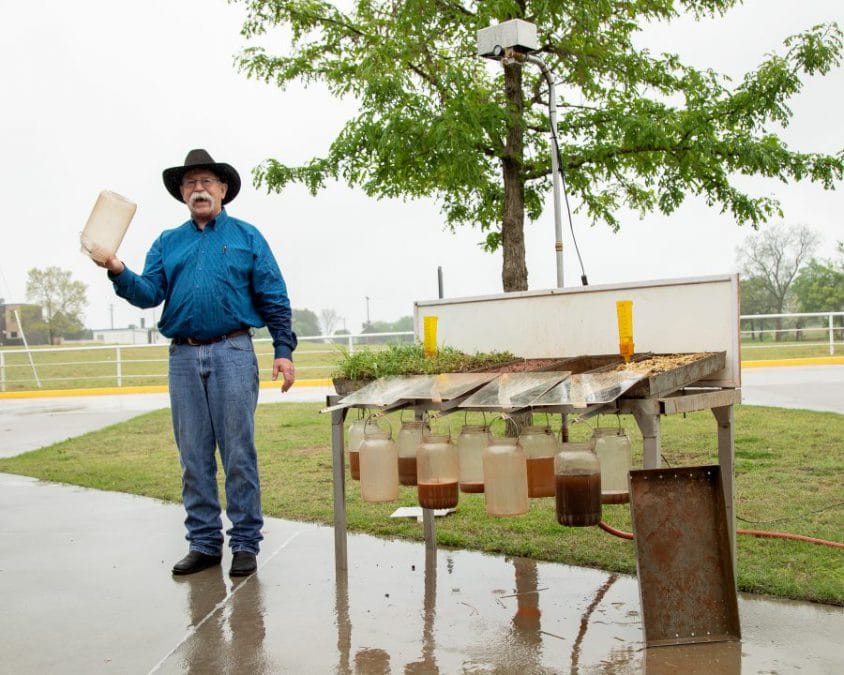Citizen Potawatomi Nation hosted a composting, soil health and conservation workshop put on by the U.S. Department of Agriculture Natural Resources Conservation Service. Open to the larger community, it helped attendees understand the development of agricultural practices over the past two decades and presented steps to reduce their domestic environmental impact. The NRCS provides grants for the CPN Community Garden Gtegemen (We Grow It), which focuses on sustainable harvesting and all-natural crops.

Soil health
Soil scientist Greg Scott led the discussion of the basics of what constitutes healthy soil. His firsthand experience dates back to 1976, along with a master’s in geomorphology. He currently works for the Oklahoma Conservation Commissions’ Water Quality Division.
“We’re helping people see the watershed as an entire entity” as opposed to broken up, Scott said. That includes the topsoil health’s effect on the water table and other layers extending deep into the earth.
The ability to ingest a large amount of water signifies the ground’s stability, which according to the rainfall demonstration at the workshop should easily be 6 inches of rain with little runoff. Large cracks and deep-rooted plants soak moisture up and complete the water cycle.
Oklahoma’s agricultural history includes topsoil erosion and monoculture, voiding fields of any other kind of greenery. In the last decade, contemporary farming reintroduced polyculture and sustainable harvesting methods. Producers now share best practices, helping spread new agricultural approaches based upon traditional techniques.
“A lot of what we teach as principles is rediscovered ancient wisdom,” Scott said.
Diverse plant communities also signify vibrant soil. Considering the soil cycle as an entity on its own, the microorganisms that simultaneously live off the plants and feed them obtain their nutrients from what each plant offers. They grow together and naturally round out the others’ gaps.
Nishnabe people refer to corn, beans and squash as the Three Sisters and grow them together, realizing they thrive off one another and provide dense sustenance. The corn stalks provide structure for the beans that in turn help convert nitrogen from the air into the soil. The squash leaves grow, cooling the earth and increasing moisture. Each contribute certain amino acids that together form complete proteins as well as fiber and iron.
Much like the Three Sisters, Scott believes the water flow shows the connections between all parts of the earth — the life cycle, soil, plants, gases, insects and more. He currently teaches what the Potawatomi knew thousands of years ago.
In today’s suburban residential settings, allowing plant life to diversify is as easy as leaving the yard alone. Mowing and weed eating keep things at a reasonable height, but a perfectly manicured lawn with the same kind of fescue drains resources.
Composting
People, especially gardeners, also practice conservation and improve their soil structure at home by composting. Assembling a hot compost pile is easy but requires some maintenance afterward. Once added to flower beds and nurseries, growers often experience a boost in blossoms and produce thanks to the increased bioavailability of key nutrients.
The NRCS workshop outlined the basics of what goes into creating organic fertilizer in the backyard.
Composting ingredients:
- Water — Important for the moisture content of the compost and sustains the organisms that break down the other elements.
- Oxygen — Maintains microorganisms’ presence in the compost and reduces odor and methane emission. Rotating and turning piles of compost introduce oxygen into the ecosystem.
- Nitrogen source — Nitrogen comes from “greens” such as coffee grounds, fruits, vegetables, leftover food, weeds without seed heads, tea bags and more.
- Carbon source — Carbon sources, or “browns,” balance out the “greens.” Sawdust, shredded paper, dry leaves, paper towels, dried grass, hay, chipped wood and newspapers act as excellent sources.
- Bio-degraders — Aerobic bacteria, fungi and worms, break down all of the organic material, converting it into plant nutrients.
Composting rules:
- Use equal proportions of “brown” and “green” material. Extensive moisture means the “greens” outweigh the “browns.” Dryness indicates the opposite.
- Turn the pile over at least twice a week.
- Do not use dairy products, human and animal waste, oil, glass or other kinds of minerals.
- Break down products, including fruits and vegetables, into smaller pieces before adding it to the compost pile.
- Add water when necessary.
